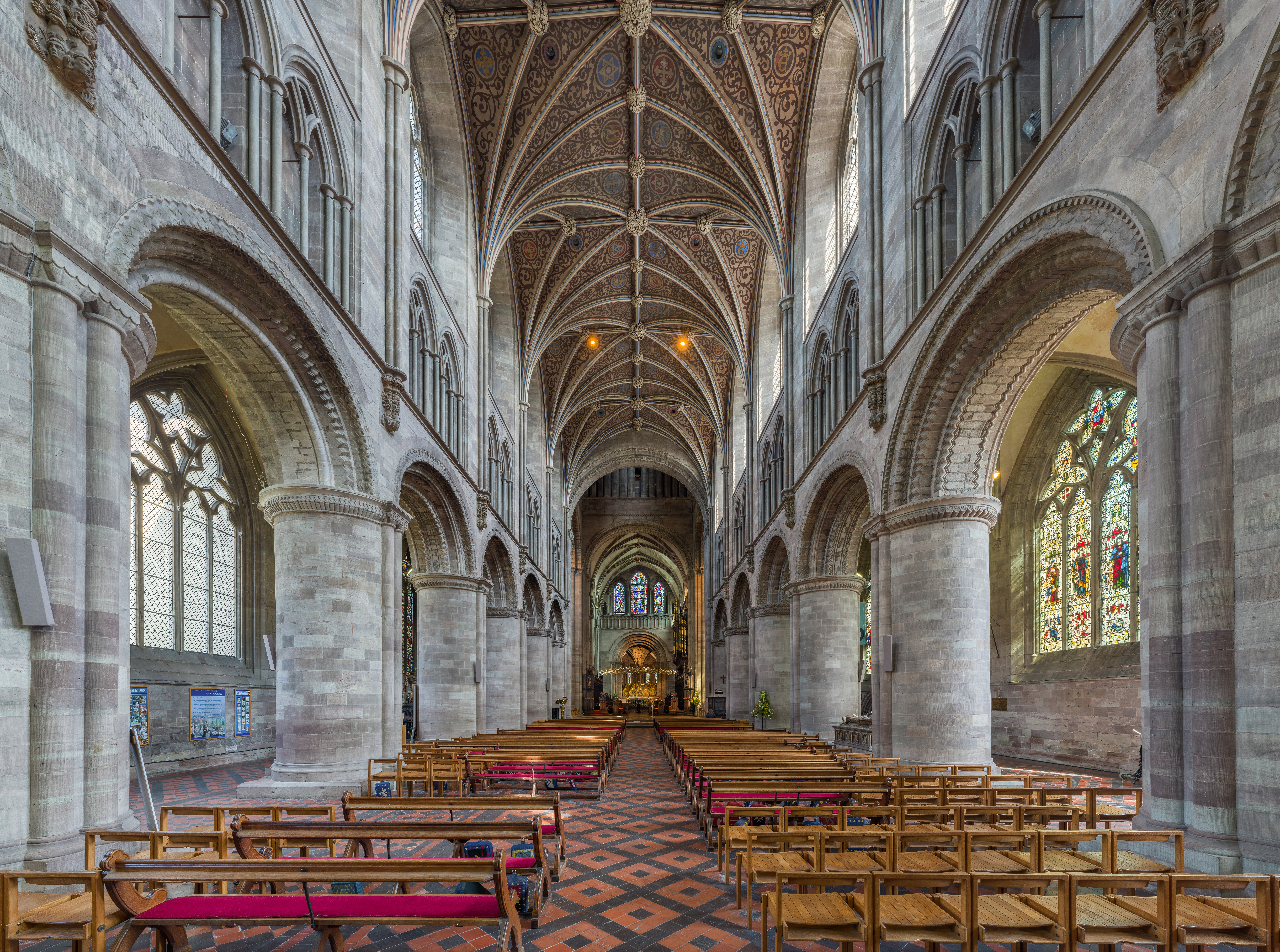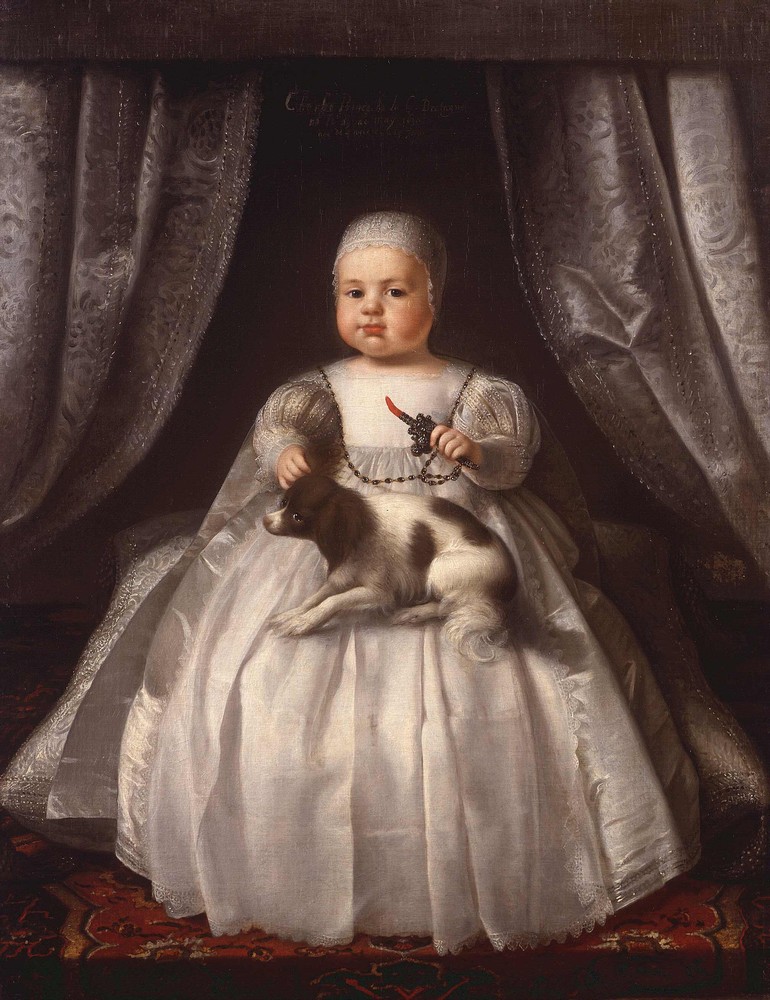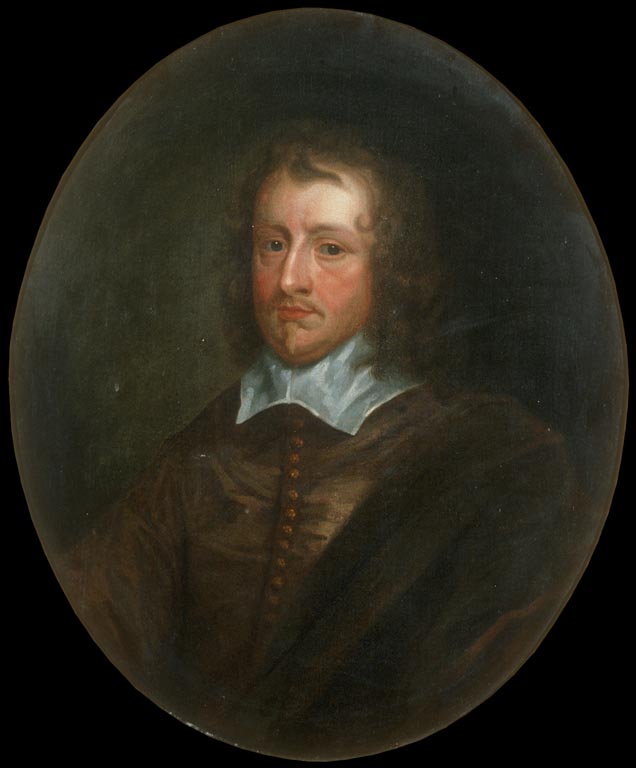|
St Mary's Church, Ware
St Mary's Church is a grade I listed parish church in Ware, Hertfordshire, England. History There has been a church on the site since the Norman Conquest. The Domesday Book mentions the presence of a priest at Ware, and the existence of a church is confirmed by a reference in another document from the reign of William the Conqueror, a charter given to Hugh de Grandmesnil.The charter gave permission to found an "alien priory" in Ware, a dependency of the Benedictine Abbey of St. Evroul in Normandy. - The chancel, the oldest part of the present building, dates from the thirteenth century, when the church served the town and the monks of the Benedictine priory. The church was restored in the nineteenth century by George Godwin. Architecture The building is faced in flint. The tower is surmounted by a short spire of the type known as a " Hertfordshire spike" (see note). People connected with the church *Charles Chauncy, who served as vicar of the church in the reign of Charles ... [...More Info...] [...Related Items...] OR: [Wikipedia] [Google] [Baidu] |
Church Of England
The Church of England (C of E) is the established Christian church in England and the mother church of the international Anglican Communion. It traces its history to the Christian church recorded as existing in the Roman province of Britain by the 3rd century and to the 6th-century Gregorian mission to Kent led by Augustine of Canterbury. The English church renounced papal authority in 1534 when Henry VIII of England, Henry VIII failed to secure a papal annulment of his marriage to Catherine of Aragon. The English Reformation accelerated under Edward VI of England, Edward VI's regents, before a brief Second Statute of Repeal, restoration of papal authority under Mary I of England, Queen Mary I and Philip II of Spain, King Philip. The Act of Supremacy 1558 renewed the breach, and the Elizabethan Settlement charted a course enabling the English church to describe itself as both English Reformation, Reformed and Catholicity, Catholic. In the earlier phase of the Eng ... [...More Info...] [...Related Items...] OR: [Wikipedia] [Google] [Baidu] |
Charles Chauncy
Charles Chauncy (baptised 5 November 1592 – 19 February 1672) was an Anglo-American Congregational clergyman, educator, and secondarily, a physician. He is also known as the 2nd President of Harvard. Life Charles Chauncy was born at Ardeley, Hertfordshire, England. The village was then known as Yardley. The manor belonged to the Dean and Chapter of St Paul's Cathedral, which leased the manor-house (a moated property called "Ardeley Bury") and the demesne lands to the Chauncy family. He was educated at Westminster School, then at Trinity College, Cambridge, where he later was a lecturer in Greek. In 1627 the College arranged for him to be appointed vicar of St Mary's, the parish church of Ware, Hertfordshire. In 1633 he left Ware to become vicar of Marston St. Lawrence, Northamptonshire. At both parishes he faced disciplinary procedures for his Puritan views which included opposition to communion rails.“Chauncy, Charles (bap. 1592, d. 1672),” Francis J. Bremer i ... [...More Info...] [...Related Items...] OR: [Wikipedia] [Google] [Baidu] |
Churches With A Hertfordshire Spike
Church may refer to: Religion * Church (building), a building for Christian religious activities * Church (congregation), a local congregation of a Christian denomination * Church service, a formalized period of Christian communal worship * Christian denomination, a Christian organization with distinct doctrine and practice * Christian Church, either the collective body of all Christian believers, or early Christianity Places United Kingdom * Church (Liverpool ward), a Liverpool City Council ward * Church (Reading ward), a Reading Borough Council ward * Church (Sefton ward), a Metropolitan Borough of Sefton ward * Church, Lancashire, England United States * Church, Iowa, an unincorporated community * Church Lake, a lake in Minnesota Arts, entertainment, and media * ''Church magazine'', a pastoral theology magazine published by the National Pastoral Life Center Fictional entities * Church (''Red vs. Blue''), a fictional character in the video web series ''Red vs. Blue'' * C ... [...More Info...] [...Related Items...] OR: [Wikipedia] [Google] [Baidu] |
Church Of England Church Buildings In Hertfordshire
Church may refer to: Religion * Church (building), a building for Christian religious activities * Church (congregation), a local congregation of a Christian denomination * Church service, a formalized period of Christian communal worship * Christian denomination, a Christian organization with distinct doctrine and practice * Christian Church, either the collective body of all Christian believers, or early Christianity Places United Kingdom * Church (Liverpool ward), a Liverpool City Council ward * Church (Reading ward), a Reading Borough Council ward * Church (Sefton ward), a Metropolitan Borough of Sefton ward * Church, Lancashire, England United States * Church, Iowa, an unincorporated community * Church Lake, a lake in Minnesota Arts, entertainment, and media * '' Church magazine'', a pastoral theology magazine published by the National Pastoral Life Center Fictional entities * Church (''Red vs. Blue''), a fictional character in the video web series ''Red vs. Blue'' * Chur ... [...More Info...] [...Related Items...] OR: [Wikipedia] [Google] [Baidu] |
Buildings Of England
The Pevsner Architectural Guides are a series of guide books to the architecture of Great Britain and Ireland. Begun in the 1940s by the art historian Sir Nikolaus Pevsner, the 46 volumes of the original Buildings of England series were published between 1951 and 1974. The series was then extended to Scotland, Wales and Ireland in the late 1970s. Most of the English volumes have had subsequent revised and expanded editions, chiefly by other authors. The final Scottish volume, ''Lanarkshire and Renfrewshire'', was published in autumn 2016. This completed the series' coverage of Great Britain, in the 65th anniversary year of its inception. The Irish series remains incomplete. Origin and research methods After moving to the United Kingdom from his native Germany as a refugee in the 1930s, Nikolaus Pevsner found that the study of architectural history had little status in academic circles, and that the amount of information available, especially to travellers wanting to inform themselv ... [...More Info...] [...Related Items...] OR: [Wikipedia] [Google] [Baidu] |
Flèche (architecture)
A flèche () is the name given to spires in Gothic architecture. In French the word is applied to any spire, but in English it has the technical meaning of a ''spirelet'' or ''spike'' on the rooftop of a building. In particular, the spirelets often built atop the crossings of major churches in mediaeval French Gothic architecture are called flèches. On the ridge of the roof on top of the crossing (the intersection of the nave and the transepts) of a church, flèches were typically light, delicate, timber-framed constructions with a metallic sheath of lead or copper. They are often richly decorated with architectural and sculptural embellishments: tracery, crockets, and miniature buttresses serve to adorn the flèche. Flèches are often very tall: the Gothic Revival spire of Notre-Dame de Paris (18582019) by Eugène Viollet-le-Duc was about before its destruction in the Notre-Dame de Paris fire, while the 16th century flèche of Amiens Cathedral is high. The highest fl ... [...More Info...] [...Related Items...] OR: [Wikipedia] [Google] [Baidu] |
Charles II Of England
Charles II (29 May 1630 – 6 February 1685) was King of Scotland from 1649 until 1651, and King of England, Scotland and Ireland from the 1660 Restoration of the monarchy until his death in 1685. Charles II was the eldest surviving child of Charles I of England, Scotland and Ireland and Henrietta Maria of France. After Charles I's execution at Whitehall on 30 January 1649, at the climax of the English Civil War, the Parliament of Scotland proclaimed Charles II king on 5 February 1649. But England entered the period known as the English Interregnum or the English Commonwealth, and the country was a de facto republic led by Oliver Cromwell. Cromwell defeated Charles II at the Battle of Worcester on 3 September 1651, and Charles fled to mainland Europe. Cromwell became virtual dictator of England, Scotland and Ireland. Charles spent the next nine years in exile in France, the Dutch Republic and the Spanish Netherlands. The political crisis that followed Cromwell's deat ... [...More Info...] [...Related Items...] OR: [Wikipedia] [Google] [Baidu] |
Sir Richard Fanshawe, 1st Baronet
Sir Richard Fanshawe, 1st Baronet PC (June 1608 – 16 June 1666) was an English poet and translator. He was a diplomat and politician who sat in the House of Commons from 1661 to 1666. During the English Civil War he supported the Royalist cause and served Charles II of England in battle and in exile. Early life Fanshawe was the fourth and youngest son of Sir Henry Fanshawe, of Ware Park, Hertfordshire and his wife Elizabeth Smythe, daughter of Thomas Smythe, of Ostenhanger Kent and was baptised at Ware on 12 June 1608. His father, who was Remembrancer of the Exchequer, died in 1616. Fanshawe was admitted at Jesus College, Cambridge in November 1623 and was admitted to Inner Temple on 22 January 1626. He travelled on the Continent, and in 1635 was Secretary to the Embassy at the Court of Spain. In 1638, he was Chargé d'Affaires there. He was an accomplished linguist, whose knowledge of "modern languages" like Spanish and Italian is said to have been a great advantage to ... [...More Info...] [...Related Items...] OR: [Wikipedia] [Google] [Baidu] |
Lady Katherine Ferrers
Katherine Ferrers (4 May 1634 – c. 13 June 1660) was an English gentlewoman and heiress. According to popular legend, she was also the "Wicked Lady", a highwaywoman who terrorised the English county of Hertfordshire before dying from gunshot wounds sustained during a robbery. History Katherine Ferrers was born on 4 May 1634 at Bayford in Hertfordshire to Knighton Ferrers and his wife, the former Katherine (or Catherine) Walters, and heiress to a considerable fortune. The Ferrers family were fervent Protestants and great favourites of both Henry VIII and Edward VI; the latter granted them extensive properties in Hertfordshire, including Bayford, Ponsbourne, Agnells, the family mansion at Flamstead, and the manor house of Markyate Cell at Markyate. Knighton Ferrers died in 1640, and Katherine's grandfather, Sir George Ferrers, died soon after. Katherine's brother, who was the heir to the family fortunes, had died young, so by court decree in October 1640, she was appointe ... [...More Info...] [...Related Items...] OR: [Wikipedia] [Google] [Baidu] |
Katherine Ferrers
Katherine Ferrers (4 May 1634 – c. 13 June 1660) was an English gentlewoman and heiress. According to popular legend, she was also the "Wicked Lady", a highwaywoman who terrorised the English county of Hertfordshire before dying from gunshot wounds sustained during a robbery. History Katherine Ferrers was born on 4 May 1634 at Bayford in Hertfordshire to Knighton Ferrers and his wife, the former Katherine (or Catherine) Walters, and heiress to a considerable fortune. The Ferrers family were fervent Protestants and great favourites of both Henry VIII and Edward VI; the latter granted them extensive properties in Hertfordshire, including Bayford, Ponsbourne, Agnells, the family mansion at Flamstead, and the manor house of Markyate Cell at Markyate. Knighton Ferrers died in 1640, and Katherine's grandfather, Sir George Ferrers, died soon after. Katherine's brother, who was the heir to the family fortunes, had died young, so by court decree in October 1640, she was appointed s ... [...More Info...] [...Related Items...] OR: [Wikipedia] [Google] [Baidu] |
Thomas Fanshawe (remembrancer Of The Exchequer)
Thomas Fanshawe (1533–1601) was a Member of the English Parliament during the reign of Queen Elizabeth I. He also held the civil service post of Queen's remembrancer of the exchequer. Background Fanshawe was the eldest son of John Fanshawe of Fanshawe Gate near Holmesfield, Derbyshire, where he was born about the year 1530. He studied at Jesus College, Cambridge, and became a member of the Middle Temple. Career His uncle, Henry Fanshawe, took him under his protection, and procured for him the reversion of the appointment of the office of Remembrancer of the Exchequer, then occupied by the elder Henry. This office was held during five tenures by members of the family. Fanshawe acquired considerable wealth in his office, to which he succeeded on his uncle's death in 1568. Besides Fanshawe Gate, which he let to his brother, he owned Ware Park, Hertfordshire (an estate he acquired in 1575) and Jenkins, in Barking, Essex, and other property. He fulfilled the duties of his of ... [...More Info...] [...Related Items...] OR: [Wikipedia] [Google] [Baidu] |
President Of Harvard
The president of Harvard University is the chief administrator of Harvard University and the '' ex officio'' president of the Harvard Corporation. Each is appointed by and is responsible to the other members of that body, who delegate to the president the day-to-day running of the university. Harvard is a famously decentralized university, noted for the "every tub on its own bottom" independence of its various constituent faculties. They set their own academic standards and manage their own budgets. The president, however, plays an important part in university-wide planning and strategy. Each names a faculty's dean (and, since the foundation of the office in 1994, the university's provost), and grants tenure to recommended professors; however, the president is expected to make such decisions after extensive consultation with faculty members. Harvard presidents have traditionally influenced educational practices nationwide. Charles W. Eliot, for example, originated America's ... [...More Info...] [...Related Items...] OR: [Wikipedia] [Google] [Baidu] |






